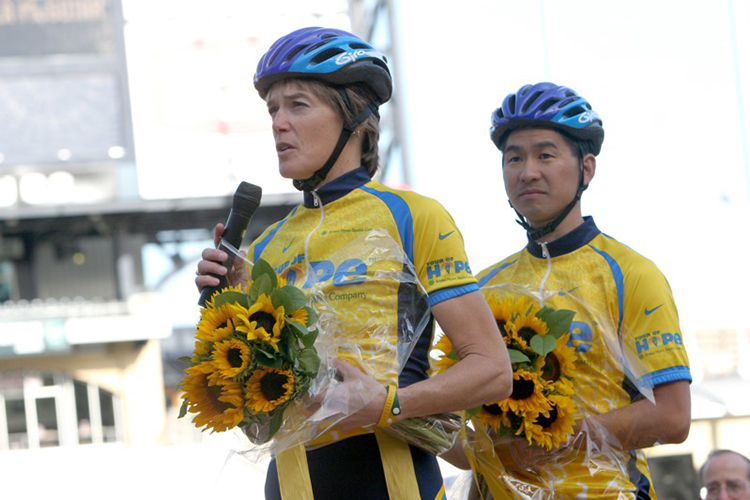
While many people many know that Sheila McGuirk, D.V.M., played a pivotal role in showring ethics and implementing the new dairy cattle check-in process, those same people may not know that she biked coast to coast in 2004.
That epic journey took place after McGuirk overcame cancer.
Our team recently interviewed Sheila McGuirk about her seven-day bike trip from Los Angeles, Calif., to Washington, D.C.
You have overcome adversity and are a cancer survivor. Talk about your love of biking and being selected as one of 20 riders along with Lance Armstrong in the Bristol-Myers Squibb 2004 Tour of Hope . . . a bicycle trip from Los Angeles, Calif., to Washington, D.C.
Sheila: I had colon cancer when our daughter was 1, and our boys were 6 and 8 years old. It was a time when Lance Armstrong also had been battling cancer and raising awareness. He was very much then at the top of his career, and biking obviously was his strength.
I had been a biker. When I came to start my career in Madison and had three children, I let biking slide a little bit. When I survived my cancer, I recommitted to paying attention to my health. If I can get back in shape, take care of my body, I am going to be here when my kids are older. So, I started biking and racing a little bit to stimulate me to train. I got back into shape.
About that time, one of my biking colleagues said I should look into this Tour of Hope. The basis for the Tour of Hope was making adults aware of the importance of participating in clinical cancer trials to advance the study of new drugs to fight cancer. The 2004 Tour of Hope was a demanding 3,600-mile trip from Los Angeles to Washington, D.C. Bikers had to average 18.6 mph, so you clearly had to have biking experience.
Over 1,200 individuals applied for Tour of Hope. Applicants had to answer questions about cancer, their experience with cancer, and a little bit about their biking experience. Then finalists were interviewed by phone, and I was a finalist and made a team of 20 riders. We trained throughout the summer.
I left the 2004 World Dairy Expo to start that journey from Los Angeles. I rode on a team of five. We rode 1,100 miles in seven days, and we ended up on the ellipse in Washington, D.C. We made presentations along the way. It was a life-changing experience for me.
As a veterinarian, I was accustomed to talking about calf diarrhea and fresh cow diseases, and for the first time in my life I was talking to 7,000 people in a Pittsburgh stadium about the importance of cancer screening and enrolling as an adult in clinical cancer trials. It was an awesome, life-changing experience.
Clearly you work well with people, even serving on the University of Wisconsin Athletic Board and on the Big Ten Conference planning sessions. How do you remain calm and be an effective leader in high-pressure situations?
Sheila: First, take deep breaths.
Understand that there is a big picture. Try to see the good in people, and try to always think that disagreements and criticism are opportunities to become better. With that in mind, I’ve never felt frustrated or threatened by disagreement. I always think that it’s an opportunity to be better. That helps me get through challenging situations.
Teams also matter. I have always felt, and am extremely lucky, that I am part of a team. I’ve never felt that I’ve been out there alone, standing alone to face anything difficult. I’ve always had a team behind me, and that has given me strength to get through some challenging times.
To learn more:
To read more about Sheila McGuirk, click on the title to read the full feature, “The cows brought her to Madison.”
Additional coverage in Hoard’s Dairyman Intel can be found by clicking the link below:
She’s the Mother Teresa of World Dairy Expo








